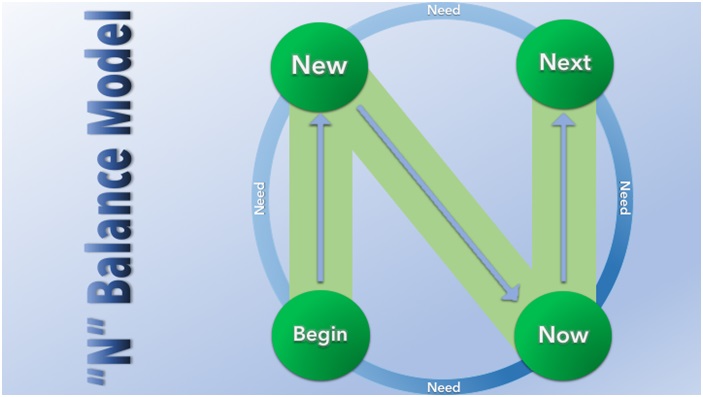A Coaching Model Created by Drew Collins
(Executive Coach, UNITED STATES)
Introduction
As a career and transition coach working mostly with professionals looking to “make a change”, I find myself working with folks that are overachievers. These individuals have spent their careers pushing themselves to “the next big thing”, often out of instinct or habit, without much thought (or concern) for the ultimate price paid for this type of full-throttle decision making. The result is successful clients that are miserable despite their success, and often the reason they come to me. With that in mind, it was important to me to develop a coaching model that respected the drive of the client, but that also caused them to strategically slow-down in the hopes of avoiding things like burnout overstretched resources, and unhappiness.
The N Balance Model focuses attention on the client’s goals while simultaneously running a parallel process focused on the needs of the client at any given stage. This allows the client to constantly push toward their goal(s) while inviting the client to think about how their decision(s) ultimately affect them as an individual. In turn, actions and decisions can be founded on the more holistic ground to achieve success through balance.
 New
New
The client begins by identifying what is “new”. In other words, what does the client want that they have not already acquired? What is the directive or goal? Perhaps it is a new position at work, a new career path, a shifted career focus, or a different mindset. Whatever the case, it should be something that the client wants to change in some way. This becomes the focus of the session and the basis for understanding what the client would like to achieve.
Now
Often we get so caught up in where we are going that we forget to see what we are doing. No matter where we want to be or what we want to achieve, there needs to be a starting point.
Once the client has identified what they would like to achieve, the NBalance Model invites the client to think about where they are today to understand where they are beginning their journey. Insights here can be used as a foundation for what will become active. Often, this stage of the model will focus on skills the client has already developed, experiences that have brought awareness/knowledge, and/or what might be missing.
Next
Planning is bringing the future into the present so that you can do something about it now. – Alan Lakein
Once a good foundation has been laid, it is time to build. The “Next” phase of the N Balance Model invites the client to start thinking about what happens next. Another way to think about the “Next” phase is as a bridge between “New” and “Now”. This phase focuses on building action steps toward the client’s goal and planning for execution. In addition to a plan, this stage may also shine a light on what the client believes could be a barrier to success and allows the client to identify what they can learn from that awareness.
Knowing what is New (what the client wants or would like to achieve) and understanding the Now (where the client is, what they have, and what is missing), what happens Next (how can the client get from “Now” to “New”)?
Need
The key to keeping your balance is knowing when you’ve lost it. – Anonymous
For many clients, this is the hardest part. Humans are infinitely adaptable, and folks that are used to pushing themselves very hard often begin to think it is normal, unavoidable, or even necessary to ignore basic needs. All-nighters, years pursuing a degree and lack of work-life balance become the norm. That is precisely why the “Need” phase is so integral to true success. What is a success if the client cannot enjoy it?
While “Need” is technically a phase of the NBalance Model, it is also much more. “Need” is what the NBalance Model sits within, a touchpoint for every other phase and the basis for which any current or future idea is viewed. “Need” is the connection to the client’s truth. Said differently, “Need” is the positive core.
In application, the coach must assess, at each phase, what the client needs to feel whole, secure, strong, peaceful…or any other positivity that the client holds at their core. This must be assessed at each phase because the core need(s) may change with forwarding movement. What a client needs to feel complete now may not be the same as what they will need in the future. Once assessed, the coach should invite the client to think about their goals and actions in the light of “Need’s” positivity. Questions at each phase may look something like this:
The idea is that by inviting the client to consider how their current and future actions may relate to and affect their physical/mental/emotional being, the client will have changed how they arrive at their outcome. Through this connection to self, the client can, consciously or subconsciously, make choices having considered their “Need”. With any luck, those choices will be more balanced under being bathed in the light of what is needed, even if only for a moment.